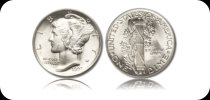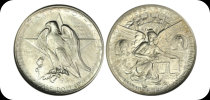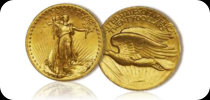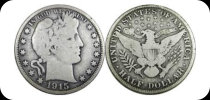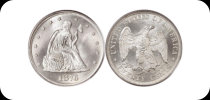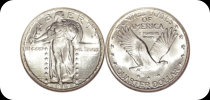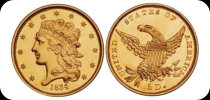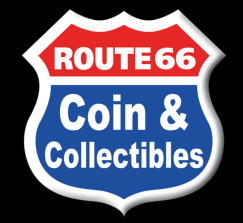©2023 Route 66 Coin and Collectibiles, LLC - 1996 E Route 66 - Flagstaff, Arizona 86004
1-928-527-0047





Want to learn more? Call us now at 1-928-527-0047
Rare Coins
Coin Investing (from the Oxford Club Investment U)
How an Investment in Rare Collectible Coins Offers Both Diversity and Profits
Van Simmons - President, David Hall Numismatics
PART 1: WHAT DRIVES THE COIN INVESTING MARKET
It’s a clear fact that the coin market moves in cycles. Both internal and external forces cause this cyclical
behavior. Internal forces are constantly working within the rare coin investing market...let's take a look at
the ones that matter the most to investors.
Like all markets… stocks, markets, commodities, currencies, commercial real estate and so on… the coin
investing market reacts to the price-driven, internal forces of the supply/demand equation. People buy
coins until prices get way too high, then they sell coins until prices get way too cheap. The market builds
momentum going each way. The cycle repeats itself again and again.
These price-driven internal supply/demand forces are very powerful. Because of these internal forces, coin
investing can experience a bull market even in the absence of bullish external forces. And that’s exactly
what happened during the internally driven bull markets of 1960-64 and 1983-89. What’s really exciting is
when both internal and external forces combine to generate the 1976-80-style bull market.
There are four major external forces that can apply pressure to the prices of rare collectible coins. In order
of importance, they are:
1. Government coinage policies and promotions
What our government does with coinage has a tremendous impact on people’s desire and ability to collect
coins. Examples include the government’s resumption of yearly proof set manufacturing in 1950, after an
eight-year hiatus. The yearly minting of proof sets beginning in 1950, and the improved packaging of those
sets beginning in 1955, helped fuel the post-war coin boom and carried through to the 1960-64-bull
market.
Government coinage policy can also have a negative impact, as was seen when the government stopped
making proof sets from 1965-67, stopped putting mint marks on coins from 1965-67, and, most
importantly, took the silver out of coins in 1965. This action put a real damper on coin collecting and
stopped the 1960-64-bull market.
Lately, the government has definitely been the coin market’s friend. The statehood quarter program,
beginning in 1999 and running through 2008, has literally brought hundreds of thousands of new collectors
to the coin investing market. In addition, the government’s resumption of commemorative coin production
in 1982, and the improved marketing efforts of these coins in the 1990s, has given coin collecting a big
boost. The government’s recent coin production, especially the statehood quarter program, is a major
reason we’re now experiencing a renaissance in coin investments and collecting.
2. What Inflation Means for Your Coin Investment
I know this is a supposedly “dead” issue, but it’s a major influence on the coin investment market. Inflation
may allegedly be dead, but the fact is that the U.S. Dollar has lost 95% of its purchasing power since
1940, and rare coins are a superb inflation hedge. In the past, the rare collectible coin market has always
done very well in periods of increasing inflation.
3. The stock market
Here's what we know about the coin investing market in relation to the stock market: Coins do well when
the stock market does poorly. This was clearly evident in the 1970-74 and 1976-80 bull market. Coins can
also do very well when the stock market does well, as was evident in the 1960-64 and 1983-89 bull
markets. But apparently, coins don’t do well when the stock market soars, as was the case in 1990-2000.
Here’s a story that may illustrate why...
I remember going to coin shows in 1999 and 2000 and seeing many dealers and collectors spending a
good deal of their time on cell phones talking to their stock brokers about their stocks. But then, so was
everyone else in the world. At recent coin shows – surprise, surprise – nobody is using their time to talk to
brokers about their stocks. They are using their time to buy coins!
4. Gold and silver prices
Since the government took the silver out of our coins in 1965, and Nixon closed the international gold
“window” in 1971, the fluctuations in gold and silver prices have had a clear impact on the rare collectible
coin market. Gold and silver bullion prices were a major factor in the 1970-74 and 1976-80 bull markets.
Investing in coins can also bode well even without huge moves in gold and silver, as it did in the 1960-64
bull market and, to a certain extent, the 1983-89 bull market.
Lately, things have calmed down a bit in this relationship. I now view bullion prices as icing on the cake. If
gold moves up, it will add fuel to the fire. If it doesn’t, investing in coins can still do extremely well if the
internal forces and other external forces are right.
PART 2: FIVE IMPORTANT ADVANTAGES OF RARE COLLECTIBLE COIN INVESTMENTS
The rare collectible coin market’s bottom-line is one of the best of all investments. In the previous sections
I explained how external conditions affect the coin investing market, and how much you can expect to
make investing in coins. Here are five more important advantages of rare collectible coin investments:
1. Liquidity
Rare coins are the most liquid of all collectibles. Since 1963, the Coin Dealer Newsletter has published
weekly dealer-to-dealer pricing information for all of the important U.S. coins. No other collectible has a
pricing structure published as frequently and accurately as rare coins. And, two or three times a month,
there are major coin shows and/or auctions where you can sell your coins. What can you expect from the
rare coin market in terms of liquidity? When the time comes to sell your coins, you can expect and receive
immediate payment.
2. Diminishing Supply
This is a subtle yet very important coin investment advantage. The supply of rare coins is diminishing daily.
Not only are they not making any more $20 Saint-Gaudens, Buffalo nickels, Walking Liberty halves,
Morgan silver dollars, etc., but also the available supply is constantly diminishing due to meltings, abuse,
neglect, etc. This is a sharp contrast to other investments. In the stock market, when they need more
shares, they issue them.
The advantage of the rare coin market’s diminishing supply is twofold. First, any increase in demand
makes price increases inevitable. The supply of coins cannot be increased to meet the new demand. The
only way new demand can be satisfied is with higher prices. Second, a limited supply reduces the
downside risk. As prices come down, production gluts (as in the oil market) do not depress prices further
and hinder a price recovery. In fact, in the rare coin investment market, low prices tend to drive coins off
the market.
3. Affordability
A painting can cost a million dollars or more. But rare collectible coins seldom cost more than $100,000.
Top-of-the-line art, diamonds and real estate all demand very large amounts of money for the purchase of
a single item. But most of the coin investments I recommend (and they are the cream of the crop) are in
the $500-to-$10,000 price range. And you can buy some important, top-quality investment coins for as
little as $100. So what can you expect from the rare collectible coin market in terms of affordability? You
can expect to participate no matter what your coin investment budget is.
4. Favorable Tax Treatment
This is a seldom talked about (but significant) advantage of coin investing, offered by the rare collectible
coin market. You do not have to pay taxes on your rare coin profits until you actually sell the coins. If you
bought 20 MS65 S-mint silver dollars for $10 each in 1977, and still had them in 1985, they’d be worth
more than $6,000. Your profit on that $200 is huge. So, how much tax do you owe? None! You haven’t
sold the coins yet. You could even take them to the bank and borrow $3,000 or more against them and
deduct the interest expense from your tax liability! Put your money in a T-bill or CD and you have to pay
yearly taxes on the interest.
5. Anonymity
All of us have different degrees of confidence (or should I say paranoia) about our government. I,
personally, feel the government’s intrusion into the private financial affairs of its citizens has become a
major concern for all investors. Of special note: those of you investing in coins do not have to file any
special government reports. Can you expect to remain anonymous as a rare collectible coin investor? Yes!
Rare Coin Investing
PART 3: THE 9 THINGS YOU NEED TO KNOW ABOUT RARE COIN INVESTING AND THE VALUE OF
RARE COINS
I’ve been in the coin business for over 40 years. Here are some of the most important lessons I’ve learned
in my professional experience that you should apply to your rare coin investing pursuits:
#1: Rare Coin Investing Allows No Bargains...There Are None.
Bargains (“rips” in the lexicon of the numismatic insiders) are a seldom-encountered exception to the day-
to-day reality of the rare coin marketplace. I’m defining a bargain as a purchase that can be immediately
resold for a profit of more than 20%. I’ll use myself as an example. Throughout the 1970s, I attended most
major coin shows. I was usually among the first to hit the bourse floor, which I faithfully scoured for “rips.”
Even though I knew rare coin values just about as well as anyone else did, and even though I was a very
aggressive buyer, I was lucky if I found one or two “bargains” per show! In other words, once or twice per
show I bought a coin for $200 and sold it for, say, $300. Most of my dealer-to-dealer coin show sales
consisted of buying a coin for $200 and selling it for $225. I concentrated on investing in rare coins at
slightly under fair market prices and selling them for a little more than I paid.
Now compare your situation with mine. You probably have neither my expertise nor my exposure to the
marketplace. If it’s difficult for me to find bargains, it’s probably impossible for you to “rip” one. You will
have enough trouble receiving fair value, i.e. buying a $100 coin for around $100. If you are offered a $100
coin for considerably under $100, there is a good chance the coin is being misrepresented (possibly
counterfeit, but most likely overgraded). Just remember: rare coin investing allows for no bargains.
#2: Value of Rare Coins: Expect Them To Be Often Overgraded.
Misrepresentation is a problem in most collectible fields (coins, stamps, art, antiques, baseball cards, etc.).
In the rare coin field the two basic forms of misrepresentation are counterfeiting and overgrading.
Counterfeiting is a fringe problem. “Reputable” dealers do not knowingly sell counterfeit coins.
Unfortunately, some of them do knowingly overgrade. The quality of a coin has a tremendous bearing on
its price. Very minute differences in quality often mean large differences in price. Many dealers yield to the
temptation to grade optimistically. The problem is particularly acute in the area of Mint State (uncirculated)
coins. As far as the 'represented' value of rare coins go, I estimate that more than 50% of all coins
represented as Mint State in advertisements and auctions are overgraded.
Your best protection against buying overgraded coins in your rare coin investing pursuits is to learn to
grade accurately. However, grading is a difficult skill to master. Still, you can be aware of the basic grading
concepts. Carefully examine every coin you purchase. Notice how sharply the details of the design stand
out. Take note of all major and minor marks. Now compare the coin with another, preferably of the same
type. The coin with the greatest detail and fewest marks is logically the better coin. Consult with friends.
But also seek professional assistance because… rare coins are often overgraded.
#3: Most Dealers Have a Limited Knowledge of Rare Coin Values.
When I first started traveling the coin show circuit, one of my most startling revelations was that many of
my “idols” weren’t all that sharp. They were good businessmen, tough negotiators, and many had great
marketing expertise.
However, as I began doing business with the major dealers, I soon realized that many of them could not
grade accurately, and even more of them could not tell you what a particular coin was worth without
reaching for the latest copy of the Greysheet (Coin Dealer Newsletter).
I would say there are about 100 people in this country that truly know U.S. rare coin values. The other
dealers are limited by their own prejudices, narrow perspective and/or lack of knowledge. All of their
limited points of view are reflected in their advertising, both printed and spoken. So be wary of all you read
and hear. Remember, most dealers have a limited knowledge of the value of rare coins, so trust your own
instincts and arm yourself with as much knowledge as you can.
#4: Auctions Are a Good Deal for Auction Companies.
Auction companies offer you an avenue to buy and sell rare coins. After looking at a couple hundred
thousand auction lots, sitting through countless hours of auction sessions, and consigning coins to most of
the major auction houses, I’ve come to the conclusion that there are better ways to buys and sell coins
and prosper from rare coin investing. Below are some of my key recommendations.
On the buying end of rare coin investing:
•
Buying coins at an auction is incredibly time consuming. You can probably do better on the bourse
floor or on the telephone, if you are a dealer, or by paying for someone else’s time and expertise, if
you are an investor.
•
With the rare exception of catching a “sleeper” bought at auction, you will probably pay absolute top
dollar for your rare coin investment. You’ll certainly pay more than any dealer, collector, or investor
in attendance would pay.
•
If you are not 100% sure of the value of a rare coin, there are several traps awaiting you, including:
dealers who consign coins to auctions and then bid them up themselves, and coins owned by the
auction company that have high opening bids.
On the selling end of a rare coin investment:
•
You have no control over prices realized.
•
All auction companies charge a 10% to 20% commission on your rare coin investment, though
some of them disguise part of the commission by calling it a “buyer’s charge.”
•
Dealer collusion is blatantly practiced at most major auctions.
•
It takes too long to sell your coins – three to six months from the time you consign them until you
receive your settlement check. Many firms offer cash advances, but they usually charge interest on
the money advanced.
•
It is much faster and more efficient to sell your coins yourself by offering them to a willing buyer.
In short, auctions are a good deal for auction companies, but probably not for you.
#5: Value is Relative in Rare Coin Investing.
Coins do not have absolute values. Coins have relative values that are constantly changing. Consider the
following stumbling blocks to accurately assess the value of rare coins:
•
Price guides do not buy or sell coins. The common mistake is to say, “This coin is worth $500,”
when all you are really saying is, “This coin catalogues for $500.”
•
Mintage is not always relevant. The number of coins supposedly made of a particular issue (mint
records are sometimes inaccurate) often has little bearing on its value. The number of surviving
specimens is the important consideration. Disregard mintage and concentrate on availability.
•
Prices can be determined only when coins are on the market. It is very difficult to pinpoint prices of
unavailable coins. This lack of accurate pricing information is often reflected in price guides and
dealer, collector, and coin investor thinking. Often, the coins that are more common are priced
higher than ones that are more rare, because recent transactions provide a frame of reference.
Look for coins that are difficult to purchase at current prices. Compare relative prices within a series. In the
rare coin investing market, value is relative.
#6: Pretzel Logic is the Predominant Mode of Thinking Among Rare Coin Buyers.
Most coin buyers, both dealers and public, buy high and sell low. The gold bullion market offers a perfect
example of this “pretzel logic.” At $250 an ounce, everybody wanted to buy gold. At $200 an ounce it didn’t
look as good, and the people who bought at $250 became sellers. Common date BU Walking Liberty half
dollar rolls were available at $275 for two years. Then they got hot and went to $600 in about six months. I
started to get calls along the lines of, “What do you think of these Walking Liberties? They seem like a
good rare coin investment.”
I’m not saying that BU Walkers are a bad deal at $600* per roll. I’m just wondering where these people
were when Walkers were at $275 a roll. Fight the psychological forces that keep you from buying
underpriced coins and from selling overpriced ones. Remember, pretzel logic is the predominant mode of
thinking among rare coin investors. *Note that the pricing time frame was January 1979.
#7: High-Quality Coins Increase In Value Faster Than Off-Quality Coins.
Now this certainly seems logical. The best quality is in the greatest demand; therefore, prices of high-
quality coins increase more rapidly. So, buy the best quality.
If you cannot afford to buy Gem gold, buy Gem Mercury dimes. If you cannot afford to buy Gem Mercs,
buy Gem Roosevelt dimes. Do not settle for less than the best. It will be much easier for you to confront
fact # 8 if you remember: High-quality coins increase in value faster than off-quality coins.
#8: Rare Coin Investing Fact: You Must Sell Your Coins.
When a coin reaches its full price potential, it should be sold. Two stock market sayings help illustrate this
fact:
•
“Bulls make money, bears make money, pigs don’t.”
•
“The only people that buy at the bottom and sell at the top are liars.”
Consider the following advantages of occasionally selling. You will be able to convert paper profits into real
profits. Plus, you will become familiar with the mechanics of the selling side of the rare coin investing
market. This could be a great help should you ever need to sell quickly. You will also find out for sure who
has been selling you properly graded coins at fair market prices. Once or twice a year you can weed out
the weak parts of your portfolio. Don’t be afraid to take losses on mistakes – consider it tuition. Move into
areas with more potential. Learn about the selling side of the rare coin investment market, because the
fact is, eventually, you must sell your coins.
#9: The Secret to Successful Rare Coin Investing is Paying a Fair Price for Properly Graded Coins.
The easiest thing to do in the rare coin market is spend money. It’s not quite as easy to receive fair value.
If you are lucky, you are buying coins from a dealer who marks his coins up 15% to 30% above his cost.
Many dealers mark coins up 50% to 100% above their cost. Some telemarketing firms use mark-ups of
200% to 300%, even 500%! The following coin investing tips will help soften the blow of excessive dealer
mark-ups:
•
Be aware of the price you are paying for coins. Study and compare coin prices.
•
Ask for buy-backs. Find out at what price a dealer would buy his coin back. Get it in writing.
•
Learn how to grade or get a grading guarantee that is very specific about the buy-back process and
price.
To participate in all the fabulous rare coin profits you read about, you must realize: the most guarded
secret to successful rare coin investing is paying a fair price for properly graded coins.
Rare Coin Price List
PART 4: THE TOP 10 ALL-TIME RARE COIN PRICE LIST
There are several thousand U.S. rare coins that are appropriate additions to any portfolio being built for
maximum profit potential. But what are the best coins in this group? What are the very best coins to have
in your portfolio?
I have compiled a rare coin price list that I feel represents the rare coin market’s 10 best bets for short-
term, medium-term and long-term potential. Let's call it “The Top 10 All-Time Rare Coin Price List.” These
are the top 10 quality examples from the five most active, most liquid, most popular, and best performing
areas of the rare coins market. Here are the criteria I used for my list:
My rare coin price list has at least one coin from each of the five major areas of the market: type coins,
rare gold, silver dollars, 20th Century singles, and silver commems. I’ve also included coins in three piece
groups: inexpensive coins ($50 to $1,000 for Gem quality examples), moderately priced coins ($1,000 to
$10,000) and expensive (or, “Big Boy”) coins (over $10,000). As usual, all recommendations apply to
MS64 or better quality coins only.
1. Saint-Gaudens
While this rare coin list doesn't follow any specific order, I decided to put the $20 Saint-Gaudens first,
because it is probably the world’s best-known coin. It is also one of the most beautiful coin designs in
numismatic history. The coin has it all – beauty, popularity, rarity (in top condition), good past performance
and, don’t forget, it’s almost exactly one ounce of “Oro Puro”! MS65. Saint-Gaudens is also one of the few
coins that didn’t flop in price during the 1980-82 bear market, even though the price of gold bullion, MS60
and MS63 Saint-Gaudens tumbled. I have said it before, but it’s worth repeating –
every portfolio should have at least one MS64 or better quality Saint-Gaudens!
[Editor’s Note: This is the coin recommended by Investment U President Dr. Steve Sjuggerud – what we call the Secret Currency. If you
want to invest in other types of rare coins, we recommend you start with one of David Hall’s other nine favorites, detailed below.]
Rare Coin Price List Group One: Inexpensive Rare Coins...
2. Texas Commemorative Half Dollar
There are many excellent silver commemorative issues, but the Texas was an easy choice for number one
commemorative on the Top 10 All-Time Rare Coin Price List. Between 1934 and 1938, approximately
150,000 Texas Centennial half dollars were minted. Probably 60% to 80% of those survive today. Of these,
approximately 50% grade MS65 or better. So, this is not a truly rare coin, just a scarce coin. The thing that
sets the Texas apart is the beauty of its design and the coin’s extreme popularity. In fact, no other U.S.
issue is associated with as much regional chauvinism (i.e. support) as the Texas half dollar.
3. Walking Liberty Half Dollar
Like the $20 Saint-Gaudens, this is one of the world’s most beautiful coins. It is also extremely popular
with coin buyers. Again, I’ve used the “most affordable” concept, though these coins are certainly not easy
to find in top condition. And all five of the 1941 to 1945 Philadelphia issues make the rare coin price
list–proof Walking Liberty half dollars are also great. They were only minted from 1936 to 1942 and they
are a little more expensive than the circulation strikes.
4. Mercury Dimes
Mercury dimes and Walking Liberty halves represent the ultimate in 20th Century numismatic beauty and
importance. Though the Mercury dime series stretched between 1916 and 1945, proofs were made only
between 1936 and 1942.
Circulation strike Mercury dimes circa 1940 to 1945 are very reasonably priced, with Gems selling for less
than $50. The proofs are a little more expensive.
Rare Coin Price List Group Two: Moderately-Priced Coins…
5. 1917 Type One Standing Liberty Quarter
Though this is one of the truly beautiful U.S. coin types, it was made for only two years. The exposed
breast of Ms. Liberty caused such an uproar that they radically changed the design halfway through 1917.
Since the 1916 is a five-figure rarity, this coin is effectively a one-year-only type coin. It makes the rare
coin price list thanks to its collective beauty, popularity, importance and rare top condition.
6. Barber Half Dollars
Barber halves were minted between 1892 and 1915. They are one of the coin market’s most important
issues. They are collected both by date and by “type” collectors. They are the rarest of the 20th Century
sliver type issues. They are beautiful and important rare coins, and both Gem quality circulation strikes
and proofs are wonderful.
7. Twenty-Cent Pieces
This odd coin was only made for four years – 1875 through 1878. The coin looked too much like a quarter
to catch on with the public and there really wasn’t a commercial need for the denomination. Today, twenty-
cent pieces are highly prized collector’s items. The design is the beautiful Liberty Seated type and all
twenty-cent pieces are rare in top condition.
Rare Coin Price List Group Three: “Big Boy” Coins…
8. Liberty Seated Dollars
This is one of the most beautiful coins ever made and one of the rarest of the major 19th Century U.S.
types. Both circulation strikes and proofs are very rare. This coin is my number one favorite.
9. Early U.S. gold coins
From 1795 to 1834, the U.S. minted $2.50, $5, and $10 gold coins. In 1834, the gold content of our coins
was lowered slightly and most pre-1835 gold coins hit the melting pot. Today, these early treasures of
American financial history are rare in all grades and super rare in Gem condition.
10. Proof Gold
Today the Mint strikes millions of proof coins a year and sells them to collectors all over the world. In the
19th Century, the Mint struck a few thousand proof coins each year and only a handful of proof gold coins.
Proof gold coins are the caviar of the numismatic marketplace… the beachfront property of rare coins.
They are expensive, but they are super rare and demand is always sky high in both good and bad
markets.
This piece was originally published in A Mercenary’s Guide to the Rare Coin Market.
